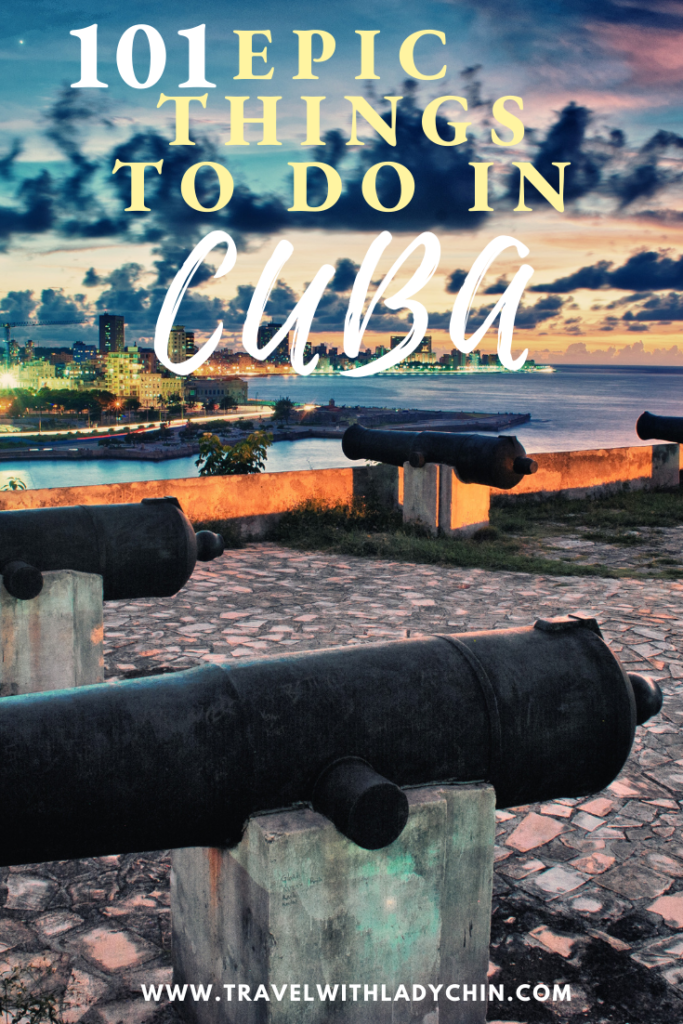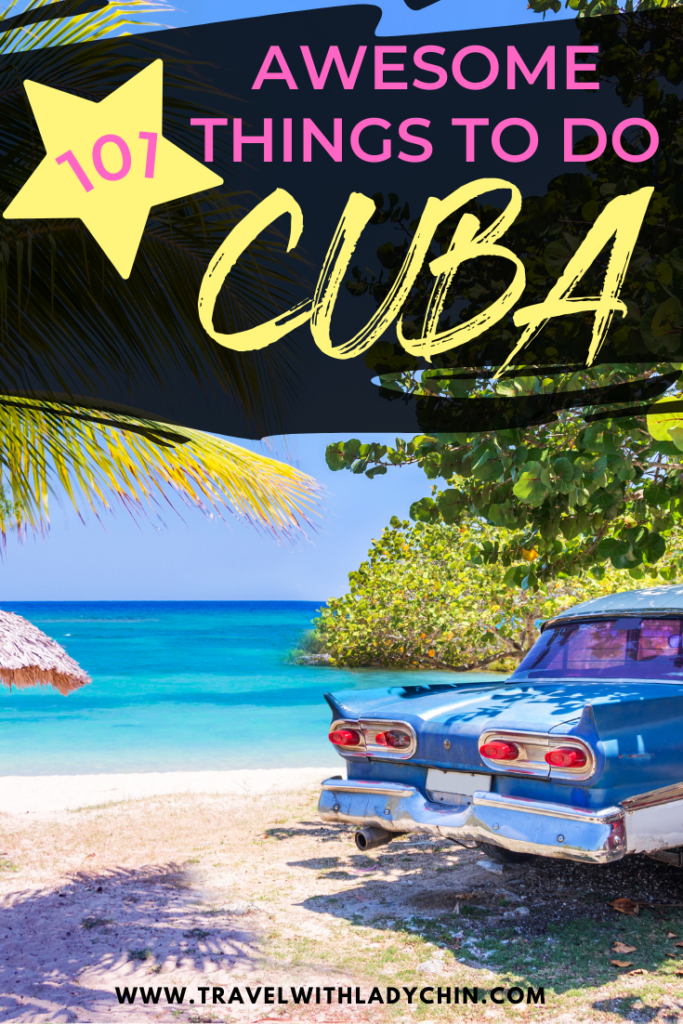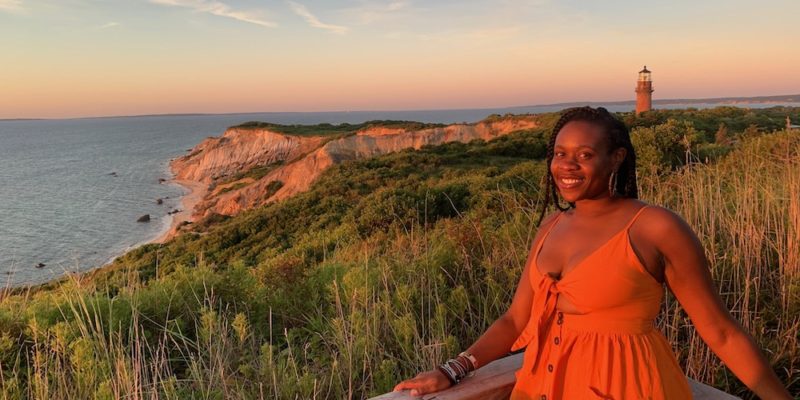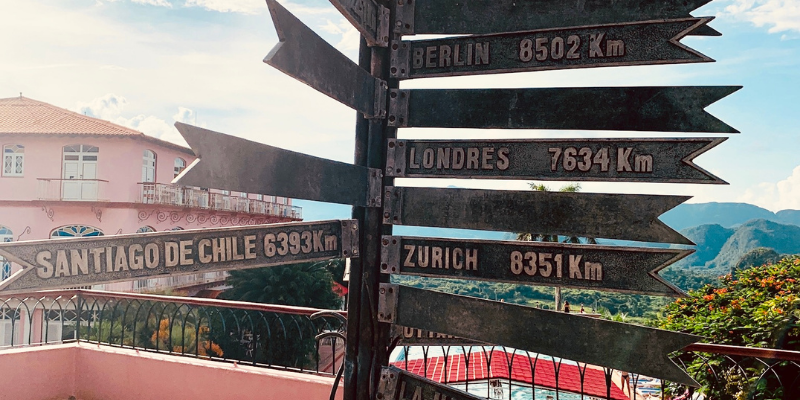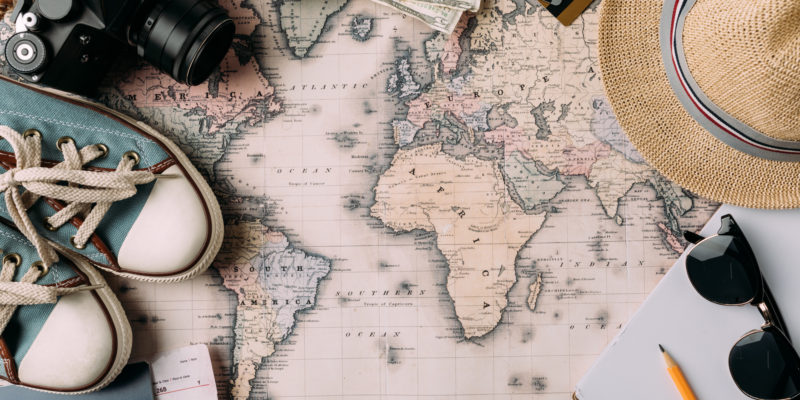Last Updated on September 20, 2023 by Lady Chin
Before I visited Cuba, I daydreamed about touring the sensational capital, La Habana, in a 1950s cherry-red Chevy jamming to ‘Rie y Llora’ by Celia Cruz. I would have a bottle of rum in one hand and a cigar that I could barely smoke in the other hand.
The first time I visited Cuba, I wanted to do the most in typical Lady Chin fashion. In layman’s terms, I wanted to do it all! I soon realized that there’s so much to do in Cuba besides riding in classic cars along the Malecón, smoking cigars, and drinking rum.
In fact, after four visits to mi Isla Querida (my dear island), I found myself discovering just how much the magical island has so much to offer. In this post, I highlight 101 things to do in Cuba so you can add to your bucket list when planning your trip.
Let’s face it: you might not have time to explore everything you want, but this guide will help you narrow down exciting activities that will spice up your holiday!
Pin Me for Later!
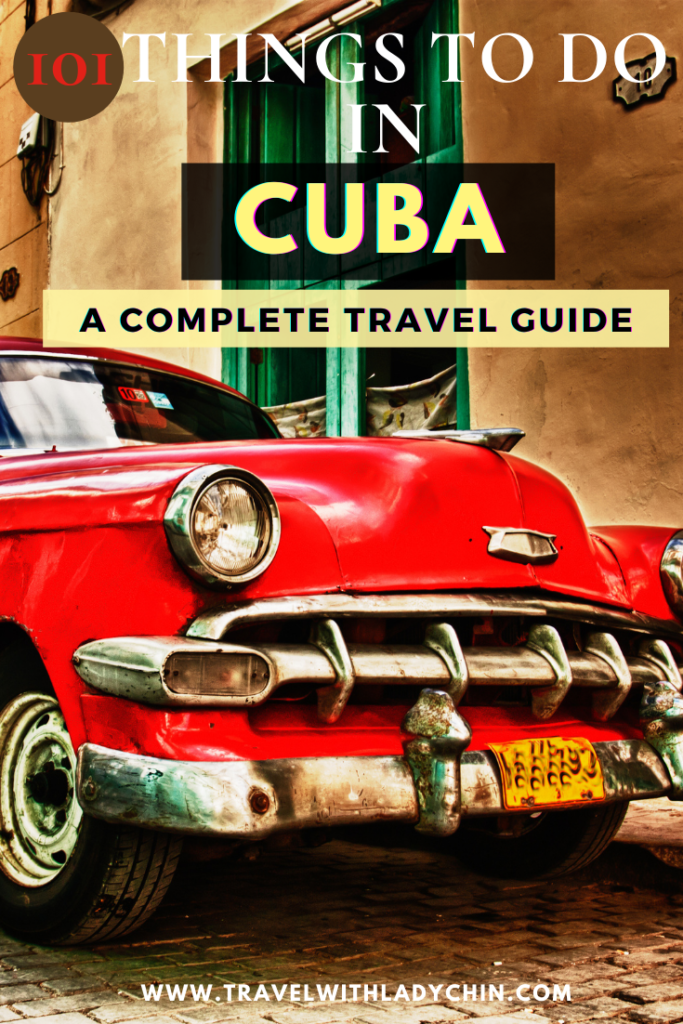
This is the fourth post in the Cuba series. Here’s the complete 10-part series:
Cuba Travel Series
Travel Guide: The Complete Travel Guide For First Time Visitors
Money Honey: Cuban Currency Guide: Everything You Need To Know
For The Culture: 36 Ways To Immerse Yourself in Afro-Cuban Culture
The Ultimate Cuba Bucket List: 101 Fun Things to Do in Cuba
Cuba Bucket List: Top 10 Epic Things To Do in Cuba
Packing Tips: The Complete Guide To Packing For Your Trip To Cuba
Inspiration: 30 Photos That Will Inspire You To Visit Cuba
Travel Tips: 10 Things You Should Know Before Visiting Cuba
Trinidad: How To Explore Trinidad in 3 Days
Viñales: How To Take the Perfect Day Trip From Havana To Viñales
101 Coolest Things To Do In Cuba
Use the map below to find the locations of all the fun things to do on this list.
Havana
Cuba’s famous capital is often the first stop on everyone’s visit. Trust me; there’s a good Cuba’s enchanting capital that is usually the first stop on everyone’s list. Trust me; there’s a good reason for that! This city receives over 2 million tourists a year (pre-COVID) and is home to some of the most influential architecture, arts, history, museums, monuments, and beaches.
1. Take a stroll or drive along the Malecón -first things first, no trip is complete without strolling or driving down the Malecón. The city is protected by a 5-mile-long seawall that stretches from Habana Vieja (Old Havana) to Vedado. Residents refer to the Malecón as the world’s biggest sofa. My favorite thing to do is sit and people-watch while the sun goes down.
2. Explore Cuban architecture and culture in Habana Vieja – you can easily spend most of your time wandering down the streets admiring the colorful buildings in Habana Vieja (Old Habana). This part of the city is full of personality and is known for its rich cultural heritage, live performances, churches, and plazas. Seeing children playing pelota, men engaging in a game of dominoes, and people chatting it up at the local barbershop was a cool way to see Cubans’ daily life firsthand.
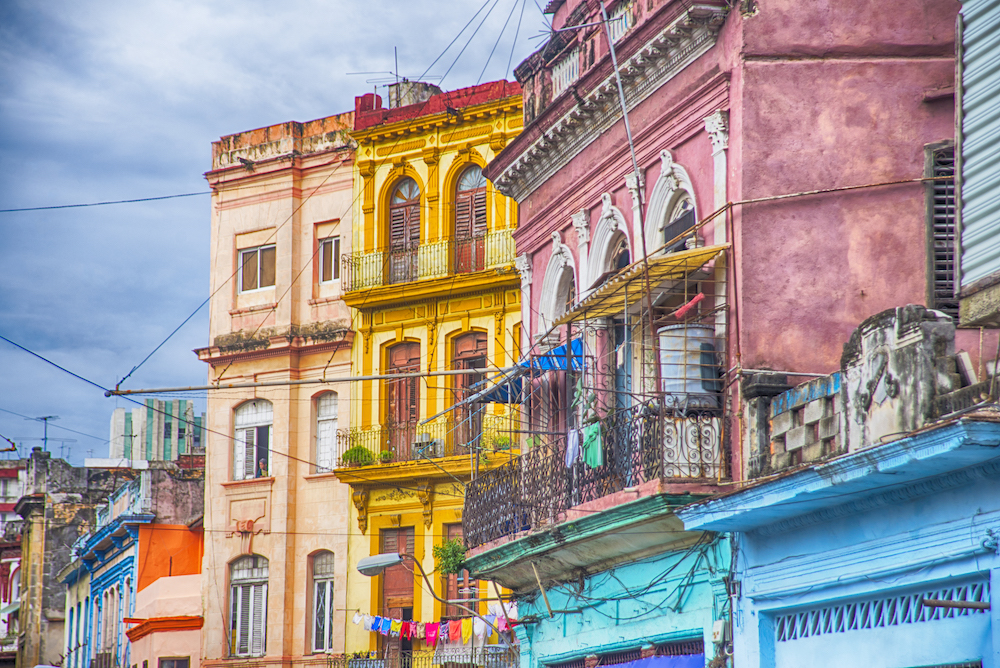
3. Explore the four plazas in Habana Vieja – if you plan to already be in Old Havana for the day, then it’s nearly impossible for you to miss one of the four plazas.
Here are some of the highlights of the four plazas:
4. Plaza de la Catedral, Cathedral Plaza – this popular plaza is usually the first place people check out. Most of the surrounding buildings, including the Catedral de San Cristóbal, date to the 18th century.
5. Plaza Vieja, The Old Square – this restored elegant plaza, once known as Plaza Nueva, New Square, is surrounded by radiant historic buildings from four centuries ago. This plaza was the most prominent public gathering place after Plaza de Armas in the 19th century. One of the most important works of 18th-century Cuban architecture in Plaza Vieja is the Casa del Conde de Jaruco, also called La Casona. Today, it’s used as an art center and is worth a visit.
6. Plaza de San Francisco – this spacious plaza located directly across the Havana harbor was my favorite. The most notable building in the square is the 18th-century Basilica Menor de San Francisco de Asis, located on the south side. Along the north side is a picturesque tower, the Lonja del Comercio. This plaza is more commercial than the others since the old customs (Aduana) house and the former stock exchange used to be there. You’ll see people hanging around the Fuente de Los Leones, the Lion’s Fountain.
7. Plaza de Armas – Plaza de Armas is the perfect place to explore the oldest and most important square in Habana Vieja (Old Habana), where the city was founded. The plaza was built in the 1600s and used for military exercises until the mid-1700s. This lush palm tree-shaded cobbled plaza became popular among the rich Habaneros and attracted people who wanted to enjoy carriage rides around the area.
8. Treat yourself to Coco Glace – Cart – if you’re in Plaza Vieja in Old Havana and looking for a refreshing yet satisfying snack, then treat yourself to a delicious Coco glasé. This yummy treat is made from coconut milk and coconut water, making it perfect for everyone, vegans included! I’m not a big fan of coconut, and I had these babies every day! You can spot the colorful red cart in Plaza Vieja.
9. Bask in the sun at Santa Maria Del Mar – Located just 20 minutes outside Vedado, this sandy beach is a favorite among Habaneros and visitors alike. We visited Santa Maria Del Mar several times due to the proximity and ease of getting there in under 30 minutes.
If you are traveling with a group, I recommend taking a taxi. It will cost between $20-$25 one way. However, you can also take the T3 bus for $5 from Parque Central, Central Park in Havana, to the beach, dropping you off near the boardwalk. The T3 bus runs every 40 minutes. There are a few restaurants near the beach and the option to rent chairs and umbrellas for an additional cost.
10. Walk Around El Morro Castle – (Castillo de Los Tres Reyes Magos del Morro) – is an important historical landmark worth visiting, especially if you are taking a city tour. This magnificent fortress guards the entrance to Havana Bay and has the most incredible views of the city.
11. Witness the Cannon Ceremony at El Morro Cabaña Fortress – the views during the day are spectacular, but the shining city comes alive at night. The Cannon Blast ceremony is one of the oldest traditions in Havana. Every night at 9:00 pm, performers dress up in the same clothing worn 300 years ago and reenact the cannon shooting from Morro Cabana Fortress across the harbor, signaling to Habaneros the closing of the walled city door.
12. Spend an afternoon at Callejón de Hamel – this 2-block alley between Aramburu and Hospital Street in downtown Havana highlights Afro-Cuban artists’ colorful and captivating murals. Deities of the Santería religion served as inspiration for some of the murals. On Sundays, between noon and 3 pm, you’ll find the alley erupts with live Rumba music and dancers by the renowned folkloric group Clavé y Guaguanco.
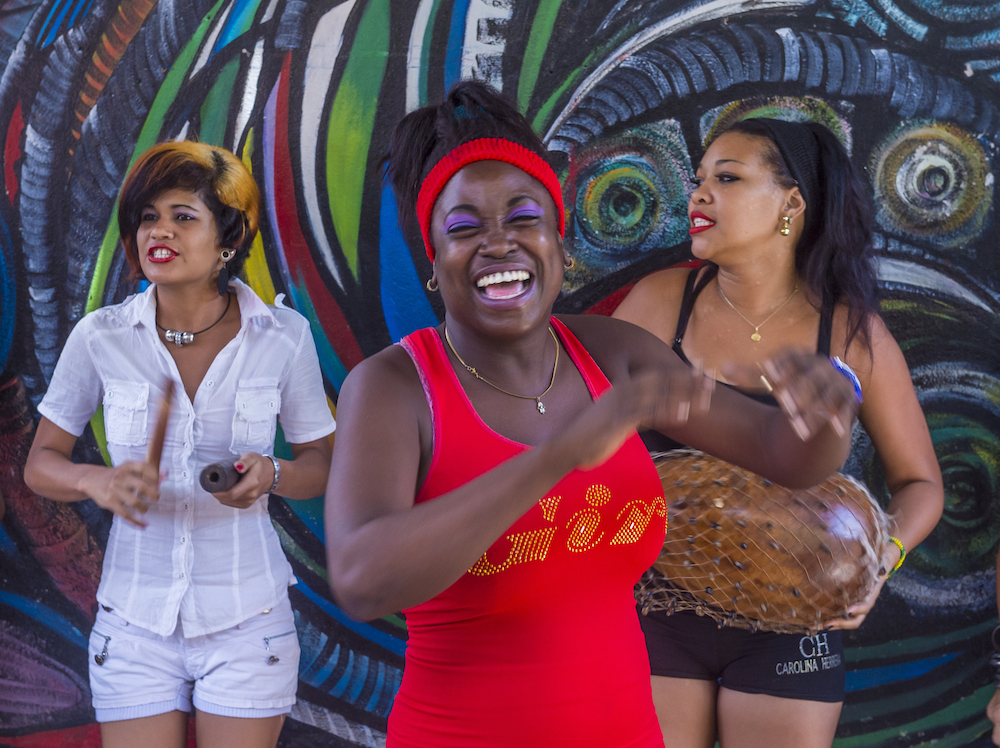
13. Take a ride in a classic car – was high on my bucket list until I found out the price, and the cheapskate in me couldn’t justify spending the money. I’ll let you in on a secret: the majority of taxis are classic cars. Instead of paying for an overpriced ride around the city, you can intentionally catch vintage car taxis to your destinations.
If your objective is solely about the experience, then you can find vintage car rides in downtown Havana near El Capitolio. The price is between $29-$34 for one seat or $99-$109 for the entire car.
14. Visit The Museo de Los Orishas (Museum of the Orishas) – if you’re interested in Afro-Cuban religion and culture, head over to the Asociación Cultural Yoruba de Cuba to see the Orishas (Yoruba deities). Located right across the street from the Capitolio, this museum has 32 life-size sculptures representing Afro-Cuban saint Gods. Descriptions for each Yourban deity are explained in English, French, and Spanish.
15. Check out La Casa de África, The House of Africa – in a seventeenth-century mansion Casa de África, which provides the historical context of Afro-Cuban culture and religion. This three-floor museum displays collections of ritual masks, ivory carvings, and textiles from African countries, along with a section dedicated to the Santería religion.
16. Join the performance at Sábado de la Rumba at El Gran Palenque, The Saturday Rumba at the Grand Palisade – every Saturday from 3- 6 pm at El Gran Parque, the Conjunto Folklórico Nacional de Cuba hosts the highly anticipated and mesmerizing dance and drum show. Visitors and Cubans come to dance to the rhythms of Afro-Cuban vibes. If you’re shy about participating, don’t worry; members of the dance company won’t hesitate to teach you a few moves!
17. Sip on a Daiquiri at El Floridita – stop at this historic fish restaurant and cocktail bar in the oldest part of Old Havana for a famous frozen daiquiri. El Floridita was a favorite hangout spot of the writer Ernest Hemingway. There’s a life-size bronze statue of him sitting at his favorite seat at the end of the bar.
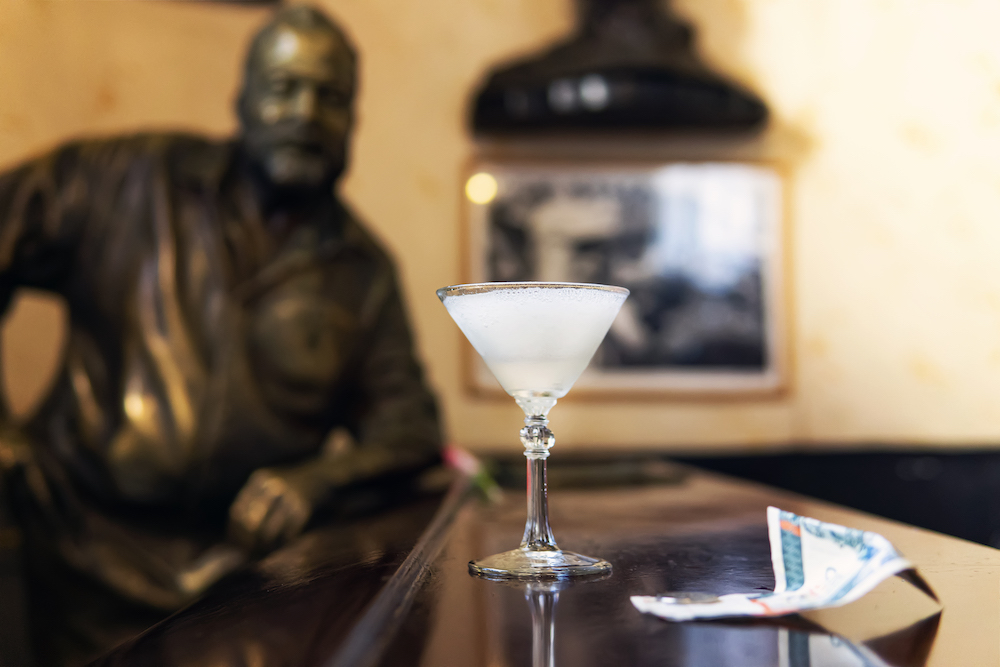
18. Strike a pose in front of the Plaza de la Revolución, Revolution Square – no trip to Havana is complete without visiting one of the world’s most symbolic and significant squares. This plaza, located in Vedado, a neighborhood in Havana, was a place for Cubans to hear Fidel Castro make countless speeches. His public addresses included marking important holidays such as International Workers Day and the anniversary of Cuba’s Revolution.
19. Visit The José Martí Memorial – situated on the northern side of the Plaza de Revolución is the José Martí monument. This enormous memorial is dedicated to José Martí, a Cuban hero, making it almost 142 meters tall and 78,50 in diameter and the tallest structure in Havana. You can visit the museum and venture up 567 steps to capture the view of the city. Alternatively, for $2, an elevator is available to take you to the top.
Tip: Make sure to walk around the entire moment so you can find 79 of José Martí’s thoughts engraved in gold, spread out into five halls. Directly in front of the monument is a 170-meter marble statue of José Martí sitting in deep thought.
20. Spend a morning exploring Fusterlandia – at this off-the-beaten path, this mosaic tile gem is 20 minutes outside Havana in a small town called Jaimanitas. Jose Fuster, the artist, spent 20 years designing his home and the entire neighborhood with colorful tiles. This free exhibit gave me Antoni Gaudí vibes. Go and see for yourself!
Tip: Fusterlandia is open daily from 9:30 a.m. to 4 p.m. (Saturdays, Sundays) and 5 p.m. (weekdays). To avoid the crowds, I recommend arriving early so you can take advantage of capturing photos and having the entire place to yourself. We arrived in Fusterlandia around 11:00 a.m., and the sun was starting to heat up. For a refreshing beverage directly across the street, have refreshing coconut water. I promise you won’t be disappointed!
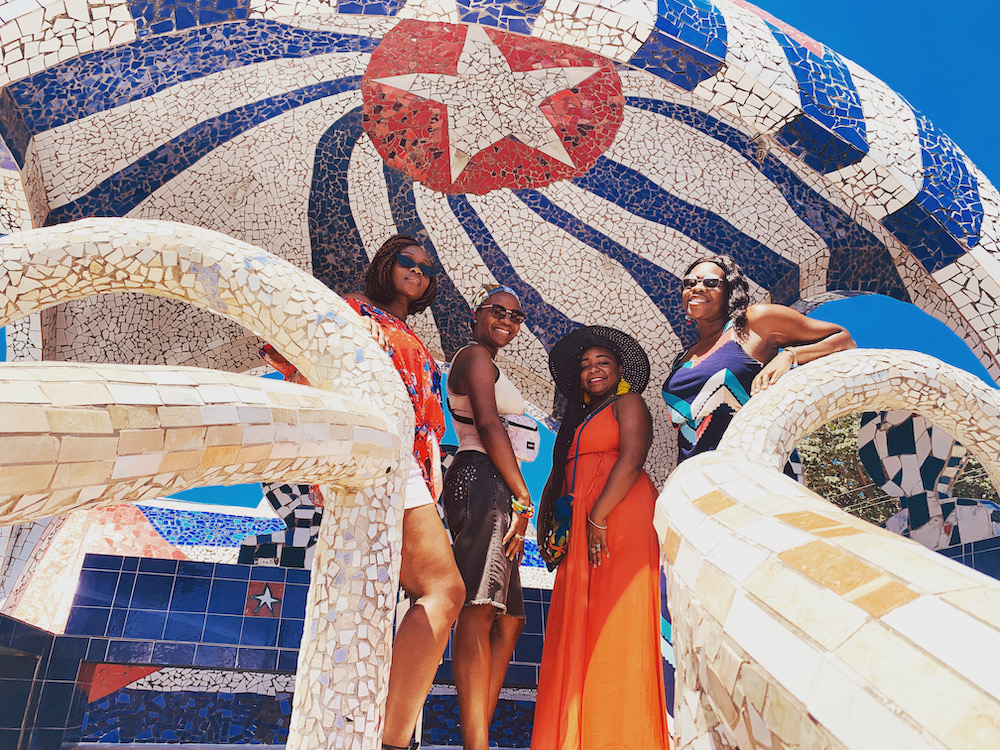
21. Visit El Barrio Chino, Chinatown – located in central Havana and the oldest and largest Chinatown in Latin America. El Barrio Chino is considered the second most important globally after San Francisco, California, United States. While the majority of Chinese Cubans left Cuba during the revolution, Barrio Chino remains as vibrant and lively as ever with its delicious restaurants, Sue-Yuen-Tong and Chi-tack.
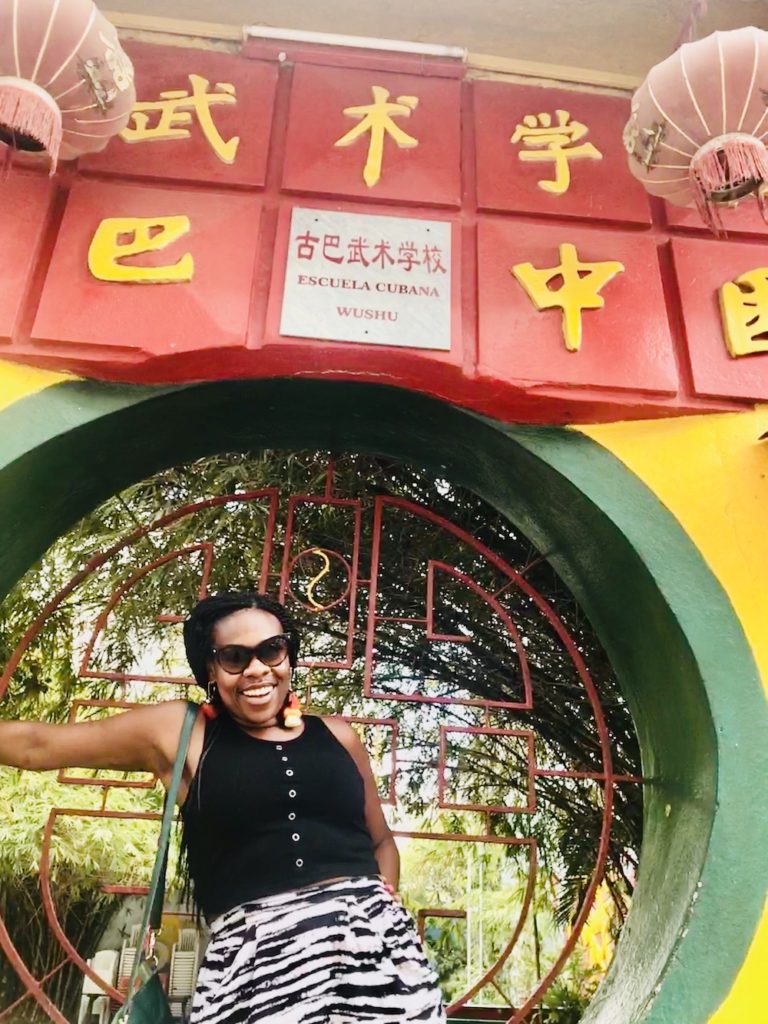
22. Take a city tour of Havana – it is a great way to get acquainted with the city. If you’re staying in a casa particular, a private home, your host can help arrange a city tour for your group. I found that informal tours are more fun, and you get the inside scoop about historical gems that you wouldn’t hear during an official tour.
23. Visit El Cristo de La Habana, Christ of Havana – is Cuba’s version of Rio de Janeiro’s Christ the Redeemer. The large sculpture overlooks the Havana harbor. To visit the Christo, you can take the ferry at the port in Old Havana across the harbor. The ferry ride is only 10 minutes.
24. Enjoy a cocktail and take in the city views at one of Havana’s rooftop bars – there are a bunch of great rooftop bars to check out. If you’re unsure about picking one over the other, I say go to both! Here’s a list of rooftop bars totally worth checking out during our visit:
- Hotel Paseo Del Prado
- Iberostar Parque Central
- Hotel Saratoga
- Hotel Nacional De Cuba
- Hotel Capri la Habana
- Hotel Ambos Mundo
- Hotel Inglaterra
- La Guarida
- La Moneda Cubana
25. Cool off with a refreshing Mojito at La Bodeguita del Medio, Havana – this famous restaurant bar in Havana attracts visitors from all over who flock to try the bar’s signature drink, the Mojito. Due to its popularity, La Bodeguita del Medio always has long wait times. Most people opt to order a mojito and enjoy their cocktail outside on the sidewalk while listening to live traditional Cuban music.
26. Take a “Selfie” Outside El Capitolio Nacional, National Capital – no trip to el Centro Habana (downtown Havana) is complete without walking or driving past El Capitolio, one of the city’s most important landmarks. This majestic building resembles the Capitol building in Washington, D.C., and was formerly used as the Cuban Congress headquarters. For a small fee, part of the building can be visited today, but be aware the building is still undergoing construction, so be prepared for partial openings and sporadic closures.
27. Visit the Gran Teatro de La Habana Alicia Alonso – if you’re a lover of ballet, opera, and performing arts, then Gran Teatro de La Habana Alicia Alonso, The Grand Theatre of Havana Alicia Alonso will be a real treat for you! Located in the heart of Havana, this grand theatre is the country’s most prestigious theatre and home to the Cuban National Ballet Company.
28. Spend an afternoon at the Museo Nacional de Bellas Artes de La Habana, National Museum of Fine Arts – one of the most impressive art museums in the Caribbean. The buildings are separated into two buildings: one for Cuban art housed in the Palacio de Bellas Artes (palace of Fine Arts), and another in the Centro Asturiano located two blocks away. If you’re an art lover, then this museum is the perfect afternoon pastime.
29. Learn about Cuban history at the Museo de la Revolución, Revolution Museum – located in the lavish Presidential Palace; this museum is perfect for immersing yourself in Cuban history. The exhibits are mainly devoted to the Revolutionary War of the 1950s and the country’s post-1959 history. I recommend starting on the top floor and working your way down to allow you to see the chronological history of Cuba.
30. Stop at the Museo de Chocolate, Chocolate Museum – if you’re a chocolate lover, then you’ve come to the right place. Here, you can see how chocolate is made and purchase goodies to take with you.
31. Go to El Gran Parque Metropolitano Parque – this hidden gem known as Bosque de La Habana (Habana’s Forest) is the only urban forest in the city and recreational area. The Anfiteatro Almendares is the only theater in Cuba designed for string-operated puppet shows where both children and adults can enjoy shows and concerts. Activities available at the park include pony rides, mini-golfing, and boating.
32. Visit the Parque Martin Luther King, Martin Luther King Park – if you’re in Vedado. The Cuban government created a dual plaque with a picture of Dr. King on one side and Malcolm X on the other side. This is a great park to sit in and enjoy the calm surroundings.
33. Walk Around La Universidad de La Habana, University of Havana – one of the oldest universities in Cuba and the Americas. It is located in the Vedado district of Havana.
34. Visit Museo de la Ciudad, City Museum – located in the former Capitanes Generales Palace, in Plaza de Armas Square of Old Havana. This palace is one of the best examples of Cuban Baroque architecture. This museum has a beautiful central patio, ideal if you’re interested in antique furniture, military uniforms, 19th-century horse-drawn carriages, and photography of Cuban history.
35. Tour the Museo de Arte Colonial, Museum of Colonial Art – in the oldest building in Old Havana, this four-room museum is filled with colonial furniture and decorative art.
36. Visit the Museo de Ron Habana Club, House of Rum – in Habana Vieja (Old Havana) to learn about the famous Cuban rum-making process and sugarcane production history. Adjoined to the museum is the Habana Club Bar, which is renowned for its live music by Solista Anita Marquetti and her band. A complimentary shot of rum is offered at the end of the tour.
37. Walkthrough the Parque John Lennon, John Lennon Park – located in Vedado. On one of the benches in the park, you’ll find a sculpture of the former Beatles member, created by Cuban artist José Villa Soberón. Due to several incidents of theft, his famous round-lens glasses have been removed. However, if you happen to see a security guard at the park, you can request the glasses to be placed on the statue to get the entire look and feel.
38. Visit Finca La Vigía, Ernest Hemingway’s home in Cuba – located 10 miles east of Havana in a small town called San Francisco de Paula, is where the author wrote two of his most celebrated novels: For Whom the Bell Tolls and The Old Man and the Sea. Today, the Cuban government owns the property, and it is one of the most visited tourist sites on the island.
39. Learn How To Play Cuban Dominoes – Dominoes in Cuba are considered a universal favorite pastime. I appreciate the game because it is played by people of all generations, genders, and classes.
The way dominoes are played in Cuba is different from other countries and combines competition with friendly camaraderie. You can’t walk down the streets in Havana or any other part of the island, for that matter, without hearing the click-clack of dominoes and laughter. If you happen to pass by residents playing dominoes, stop and watch, or if you’re feeling brave and know how to play the game, join in!
40. Explore The Graffiti Art – Havana has no shortage of street art, and on every street I turned down, I discovered an abundance of eye-catching murals of artistic expression. If you’re into graffiti, Centro Havana, Old Havana, and Vedado are the best places for finding the best and most unique street art in the city. Graffiti in Centro Habana has a heavy Afro-Cuban influence of native style, geometric shapes, shiny colors, religious icons, and phrases in Yoruba.
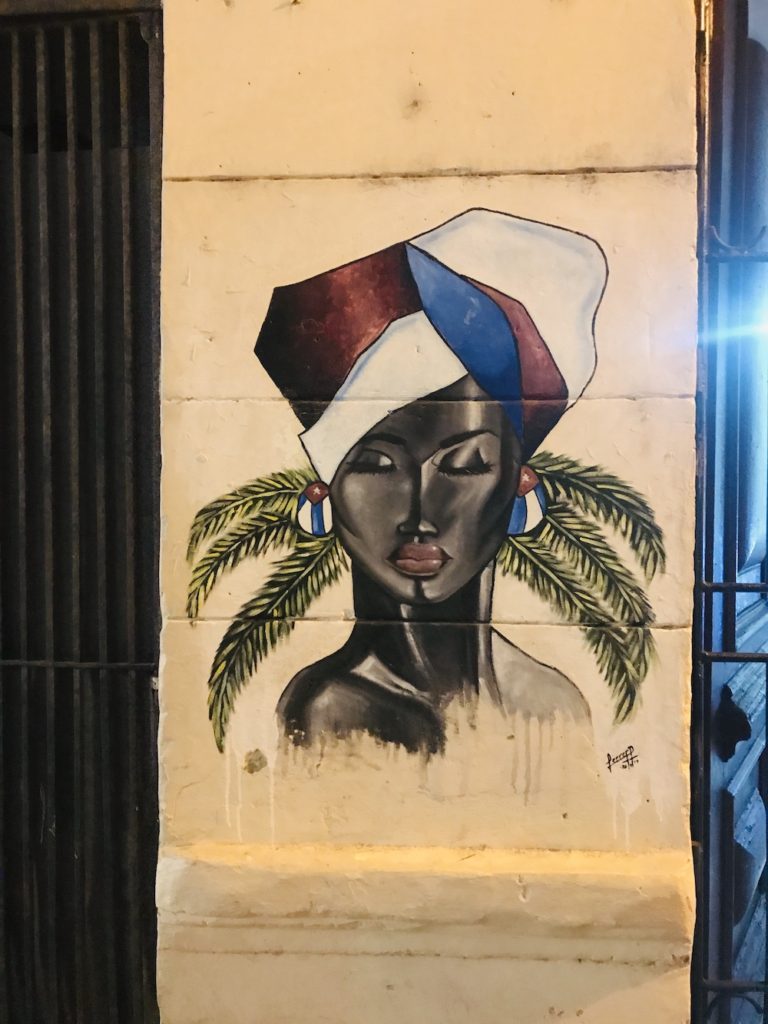
41. Take a Photography Tour – On our second to last day in Havana, we decided to take a photography tour we found on Airbnb activities. For $20/person, our guide took us on a private tour of capturing photos of the city’s architecture and learned about lighting techniques and essential pro-photography tips.
42. Visit La Guarida – I first discovered La Guarida, Cuba’s most celebrated paladar, a private restaurant, during a photography tour. Walking into the building entrance is breathtaking, and your eyes are immediately directed to the magnificent marble staircase that leads to the restaurant. If you happen to visit La Guardia when the restaurant isn’t open, it’s still worth wandering around the building, snapping photos, and checking out the fabulous views of Havana.
43. Dine at El Cimarrón – this lovely paladar, private family-owned restaurant in Vedado was my favorite place to eat in Havana. Alexis, the owner, and his family provided an inviting space to enjoy traditional Cuban food, admire the African artwork covering the walls, and soak up the Afro-Cuban music and vibes. The seafood is fresh and flavorful.
44. Enjoy Ice Cream at Coppelia – ice cream, you scream, we all scream for ice cream! Coppelia’s is an ice cream parlor chain located in Vedado off Avenida 23 (best known as La Rampa) was built by Fidel Castro in 1966. This Jetson-like space-age building is a popular destination for Habenros and their families. The flavors are relatively limited, and I suggest sticking with a simple flavor like chocolate. The lines can be long, so be prepared to wait.
45. See a Dolphin Show at the Acuario Nacional de Cuba National Aquarium – located in the ritzy neighborhood of Miramar, 10 minutes from downtown Havana. The aquarium is an ideal stop if you’re traveling with children and want to experience the dolphin or sea lion show. This aquarium focuses on research, environmental protection awareness, and the promotion of sea plant and animal life. Go with an open mind; due to U.S. sanctions, you’ll notice the facility isn’t in the best shape. The aquarium is famous among residents.
Artemisa Province
Located right outside Havana, this tranquil oasis is the perfect place to disconnect, recharge, and enjoy nature.
46. Take a day trip to Playa Baracoa – this is a cute fisherman town located 13 mi or 30 minutes outside Havana in Artemesia, Providence. This small town has a great vibe and makes for an ideal escape as it’s close enough to the city but far enough away from the bustling capital.
47. Visit Las Terraza – one of the best-kept secrets in Cuba. While it’s an easy day trip from Havana and on the way to Viñales, not many tourists have heard of it. Las Terrazas is a small community and nature reserve located in the Artemisa province in the Sierra del Rosario mountains. What’s unique about Las Terrazas, Cuba, is that it is an authentic eco-resort and popular among Cubans looking to enjoy their holiday. I haven’t visited Las Terrazas, but it’s high on my list for my visit trip.
Fun Fact: Fidel’s vision for making this area eco-friendly started with planting more than 7 million trees between 1968 and 1978. There are only 1,200 inhabitants, and you cannot simply move there. You must marry a local or have a particular skill needed, such as an electrician, you can be invited.
Bayamo
Bayamo is the birthplace of Cuban independence and a hub of colonial culture. Bayamo is known as La Ciudad de Coches, the city of carriages. Over 500 horse-drawn carriages make up about 80% of the city’s transportation.
48. Go to Fiesta de la Cubanía – to enjoy the main cultural event in the province. The festival is held yearly in October and represents Cuban history, culture, art, and literary works.
Ciego de Ávila
Cayo Coco, or the Keys, is located in east-central Cuba in the Ciego de Ávila province. The fourth-largest island in Cuba is known for its all-inclusive resorts, pristine beaches, and shallow, clear blue water. Tourists flock to this part of the island to recharge.
49. Relax in Cayo Coco – this tropical island in the Jardines del Rey has gorgeous beaches, coral reefs, and a variety of all-inclusive resorts. Cayo Coco is home to birds such as the white ibis and native pink flamingos.
Cienfuegos
Cienfuegos, also known as La Perla del Sur (Pearl of the South), is located on the southeastern coast of Cuba. Founded by French colonists in 1819, this port became a commercial center for sugarcane, tobacco, and coffee. Enslaved Africans built the town, and today, African cultural traditions remain.
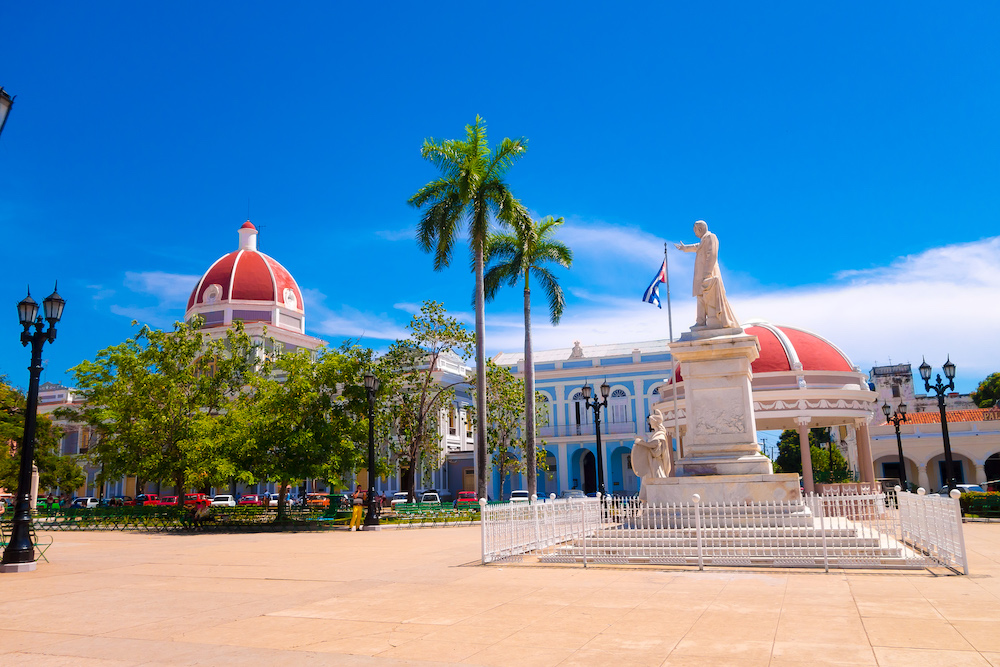
50. Witness the Hemp Drum in Palmira – located 10 kilometers from Cienfuegos, the town of Palmira is known for keeping the Afro-Cuban religion alive by honoring and celebrating the Orishas through a celebration of drums of stick or hemp, song, and dance. On December 4th, the main Yoruba festivity commemorates Saint Barbra and the Orisha Shango, the god of war and owner of lighting and thunder.
51. See Flamingos at Laguna Guanaroca
If you’re in Cienfuegos, then make sure to add taking a tour around Laguna Guanaroca to your list! The Guanaroca Nature Reserve is a mangrove lake right outside Cienfuegos. It is the only natural protected area in Cienfuegos. Here you can see more than 2,000 pink flamingos, along with pelicans and trogons (Cuba’s national bird).
Tip: Arrive early to increase your chances of seeing the variety of birds and wildlife.
El Cobre
Located just 14 miles outside Santiago de Cuba, El Cobre is considered a milestone in the history of Slavery in the Caribbean.
52. Go to the El Monumento al Cimarrón, The Monument to Runaway Slaves – directly across from the Virgen de la Caridad stands El Monumento al Cimarrón. The bronze and iron sculpture created by Afro-Cuban artist Alberto Lescay symbolizes resistance and freedom. The monument glorifies one of the most significant slave uprisings in the island’s history – the successful July 24th, 1731, insurrection of enslaved Africans working in the mines of El Cobre.
Matanzas
Matanzas is located on the northern shore of Cuba and is one of the wealthiest areas of the island. Enslaved Africans worked on the sugar plantations during the colonial era. Due to the vast numbers of enslaved Africans and Afro-Cubans, African influence and traditions remain strong. Matanzas is known for its poets, music, dance traditions, culture, and Afro-Cuban folklore.
53. Visit the Museo Nacional Ruta del Esclavo, Slave Route National Museum – this 17th-century San Severino Castle turned UNESCO-selected museum for the Slave Route Project. The exhibits address the origins of plantation systems, abolition and emancipation, and the ongoing legacies affecting people of African heritage around the world.
54. Spend the day at Playa Girón – This beach town in the Matanzas province is famous for diving and snorkeling, also famously known as the Bay of Pigs invasion site.
55 . Go wildlife spotting in the Zapata Peninsula – located south of Matanzas; take a guided tour around the Zapata Peninsula to see flamingos, pelicans, hummingbirds, swamps, crocodiles, lizards, and more! Be sure to ask your guide to take you to Bidos Salt Mines, where birds congregate. – south of Matanzas
Tip: If you have time, be sure to check out Cueva de Los Pesces (Fish Cave).
Regla and Guanabacoa
These two small towns, conveniently accessible by ferry, are situated on the eastern side of the Old Havana harbor. Less visited by tourists, these municipalities are historically known for their rich Afro-Cuban culture and Santería traditions.
56. Immerse yourself in Afro-Cuban religion at el Museo Municipal de Regla, Municipal Museum of Regla – this important museum exhibits lots of history about the town of Regla and Afro-Cuban religions. Don’t miss the room dedicated to the Orishas (deities of the Santería religion), Palo Monte ngangas (cauldrons), and the masked Abakuá dancing figurines. The museum organizes guided tours of Regla for a small fee.
57. Explore La Iglesia de Nuestra Señora de Regla , The Church of Our Lady Regla – originally a haven for enslaved Africans, this church is home to one of the most famous religious icons in all of Cuba, La Santísima Virgen de Regla (The Blessed Virgin of Regla). In Santería, the Black Virgin Mary (Black Madonna) represents the African goddess of the ocean, Yemayá. Like most of the attractions in Regla, this church shows a combination of African and Catholic traditions.
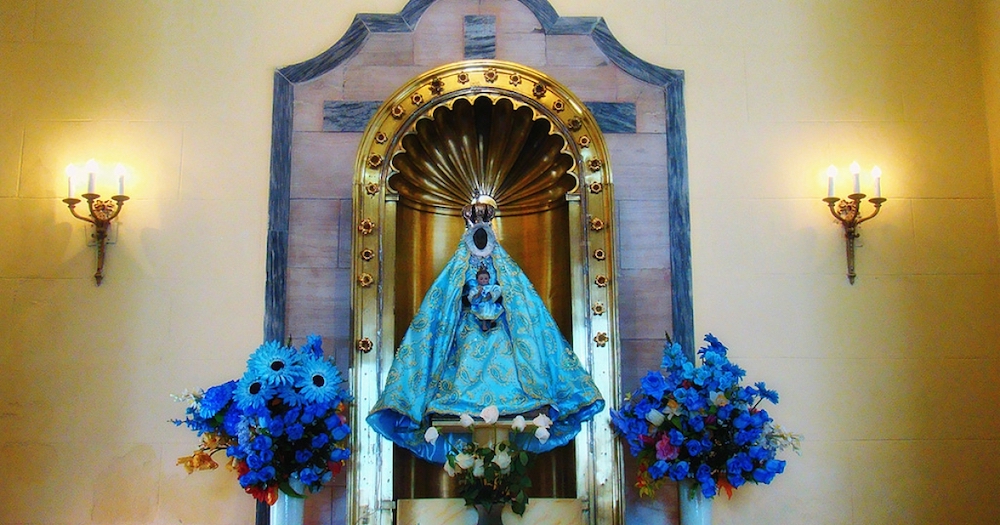
58. Tour the Museo Municipal de Guanabacoa, Municipal Museum of Guanabacoa – similar to the museum in Regla, it’s filled with important Santería artifacts introduced into Cuba by three African religious groups during slavery. Don’t miss the rumba, folkloric shows, and rare artifacts from the Palo Monte and Abakuá religions.
Santa Clara
The fifth-most populous city in the province of Villa Clara is known for its history of war and famous landmarks. Also referred to as “Ciudad Liberal,” Free City” is not to be missed, especially if you’re interested in the Cuban Revolution.
59. Visit Mausoleo del Che Guevara, Che Guevara Mausoleum – is a dedicated memorial located in Plaza Che Guevara (Che Guevara Square). The mausoleum has the remains of Ernesto “Che” Guevara and twenty-nine of his fellow combatants killed in 1967 during an uprising in Bolivia. Visiting the mausoleum is an integral part of Cuban history and is not to be missed, especially if you’re in the area! There’s a small museum which is free to enter, but note cameras are not allowed.
Santiago de Cuba
The second-largest city in Cuba and home to the most significant number of Afro-Cubans. The city is known for its culture and traditional dances, most notably son, derived from salsa. If you’re in Santiago de Cuba in July, be sure to check out the oldest and most authentic street carnival.
Fun fact: Santiago de Cuba is the birthplace of the world-famous Bacardi rum brand. Founded by Facundo Bacardi Masso in 1862.
60. See the Plaza de la Revolución, Revolution Plaza – at the city entrance, an enormous monument of Afro-Cuban General Antonio Maceo Grajales sits atop his horse surrounded by 23 giant raised iron machetes pointing towards the sky to signify the daggers in the sides of the colonial power. Beneath the monument is a modest museum dedicated to the General.
61. Visit Castillo de San Pedro de la Roca – this large fortress is considered one of the best in Cuba, located about 6 miles southwest of the city center, offering magnificent coastal views. A small museum is located on the property with local guides who will share the fort’s history. The tour is in Spanish, and helpful to have a translator handy.
62. Visit Museo del Carnaval, Carnival Museum – Santiago de Cuba is considered one of the most vibrant festivals. This museum captures the essence of the city’s enthusiasm for the holiday. Here, you will go on a short tour to learn about the history of Cuba’s oldest and biggest carnivals between Río and Mardi Gras. The rooms display floats, extravagant costumes, carnival accessories, and effigies. Live performances are held throughout the day.
63. Have fun at the Carnival de Santiago, Santiago Carnival – one of Cuba’s most famous and fun festivals. Every year between July 18 and 27, Santiago de Cuba attracts visitors and Cubans alike to celebrate family togetherness with lots of dancing, music, great food, and plenty of libations. Like many of Cuba’s festivals, Carnival de Santiago began as a religious event celebrated by Santiago’s enslaved Africans, who introduced dance, culture, music, and costumes typical of carnival.
64. Don’t miss the Festival Del Caribe, Caribbean Festival – immerse yourself in the culture, art, and traditional music. The Caribbean festival runs during the first week in July (July 3-9) and is a fantastic opportunity to experience colorful performances, exhibitions, workshops, and street activities. The theme for the festival is unity among the entire Caribbean. The Caribbean festival is similar to the Notting Hill Carnival in London. Mainly due to food from different parts of the Caribbean and all-night parties involving copious amounts of rum!
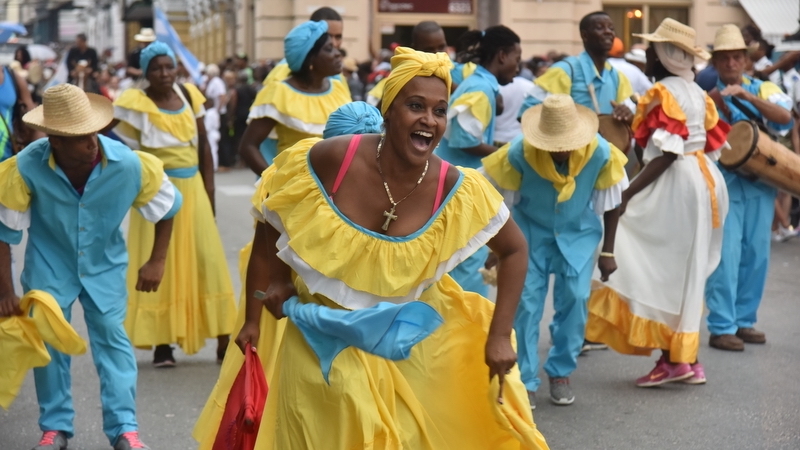
65. Spend an afternoon at the Casa del Caribe, Caribbean House – a cultural institution that organizes the Festival del Caribe and hosts various concerts. For a deep dive into the Afro-Cuban religions and cultures, the institution can arrange tours, workshops, and dance lessons for an additional fee.
66. Visit Casa de Las Religiones Populares, The House of Popular Religions – to explore the island’s religions, from Catholicism to Santería, and the unique rituals that meld the two. The entrance includes a guided tour of this santériste temple and more.
Trinidad
Trinidad is a beautifully preserved colonial town in the province of Santi Spiritu, central Cuba. In 1988, it was named a world heritage UNESCO site. This cute town has pristine cobblestone streets, inviting sherbert-colored homes, and picturesque views of hills and valleys for days, making it an ideal spot for a full-on photo shoot. Trinidad is a popular destination for tourists and has a calmer vibe compared to Havana.
67. Stroll through Plaza Mayor – Plaza Mayor was built back when the region was rich from sugar plantation wealth. Located in the city center near many restaurants, Plaza Mayor is the ideal place to start your adventure. The plaza is surrounded by exquisite raised gardens, fancy cast-iron benches, cobblestone streets, and historical buildings from the 18th and 19th centuries. Plaza Mayor is great for people-watching, but be warned that this area is the main tourist attraction, so be prepared for vendors trying to sell you things.
68. Wander down the cobblestoned streets – it’s nearly impossible to get lost in Trinidad, given its size. Spend a few hours roaming around the charming city. As you get away from the city center, you’re welcomed by a striking backdrop of mountains and houses painted the color of sorbet. A highlight for me was making friends and catching a game of dominoes.
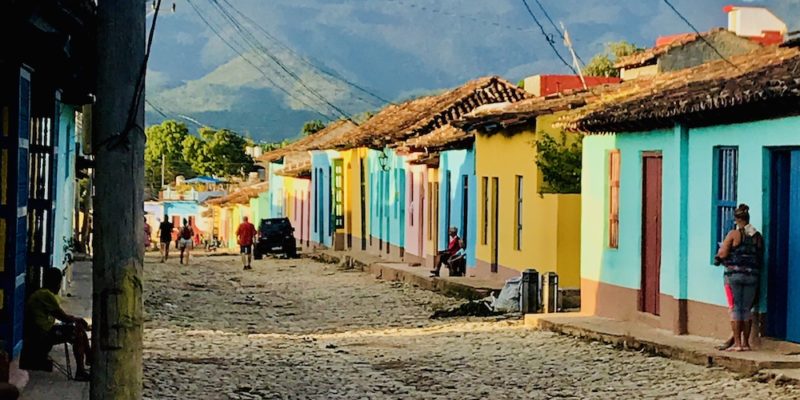
69. Take a day trip to Valle de Los Ingenios, Sugar Mill Valley – to learn about the history of sugar cane production in Cuba. Valle de Los Ingenios is a series of three interconnected valleys about 7.5 miles outside Trinidad, Cuba. During the 18th and 19th centuries, this region had over 30,000 enslaved Africans working in the sugar mills/fields, allowing the Spanish to dominate the sugar industry.
70. Start your day at Manaca Iznaga – one of the only intact plantations in the area where the owner’s house, a tower, and original enslaved quarters remain. Pay a small fee to climb dozens of stairs of the 149-foot tall Manaca Iznaga Tower, leading to the observation deck with stunning views of Valle de Los Ingenios. The tower served as a lookout for watching the enslaved Africans.
71. Enjoy a steam train ride – a fun way to explore Valle de Los Ingenios is to catch a steam train from Trinidad. This railroad route dates back to the late 1800s and was created to transport sugar to the port town of Casilda. On this tour, you’ll have the opportunity to pass through the beautiful landscape of sugar cane plantains and visit other attractions.
72. Head to Playa Ancón, Ancón Beach – if you’re a beach lover like me and looking to chill out, then I highly recommend you set a day or afternoon aside for the beach! Beach Ancón is fantastic! The water is crystal blue, and the sand goes for miles! The beach is conveniently located just 15 minutes from Trinidad.
73. Go for a hike in Topes Collantes – if you’re looking to spend a day in nature, hiking in Topes Collantes is your best bet! Topes de Collantes Natural Reserve stretches across the Escambray mountains in southern Cuba. While you can hike the trails independently, you can ask your driver to go on the hike with you, as I did. The thought of walking in the woods for an hour in unfamiliar woods wasn’t an option for me.
74. Cool off with a swim at Salto del Caburní – After an hour’s hike through Topes Collantes, we were greeted by a lovely waterfall that spilled over giant rocks into a stunning swimming hole. A small fee is collected at the entrance of Villa Caburní, right down the hill from the Kurhotel near the Centro de Visitantes visiting the center.
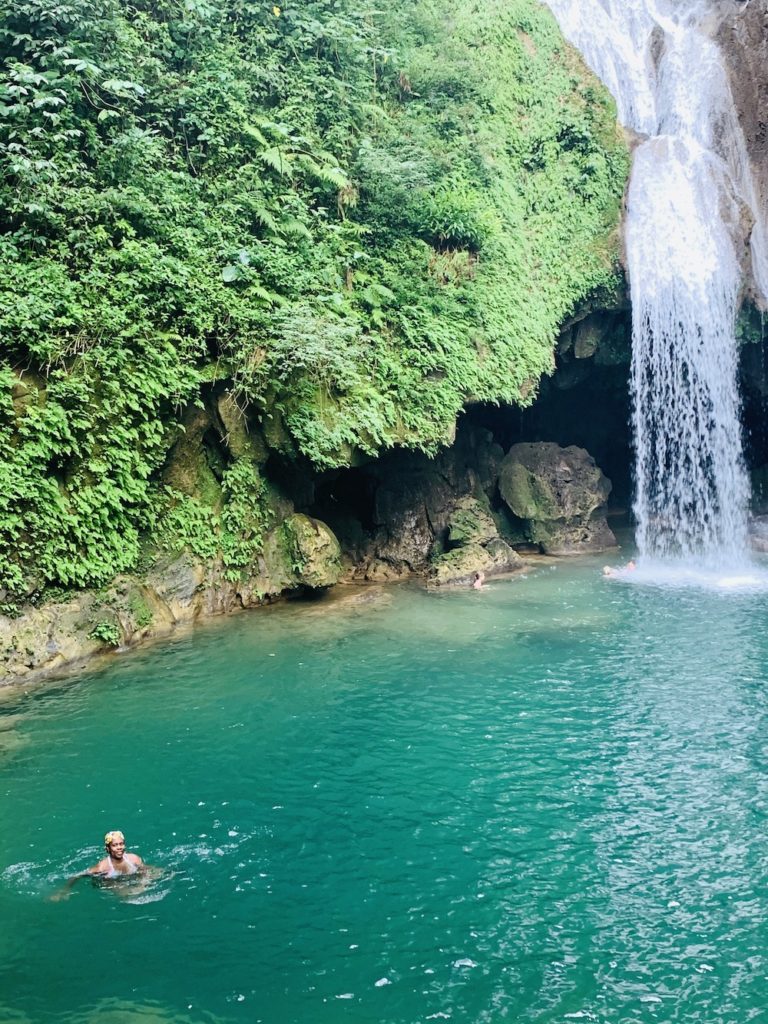
75. Treat yourself to a cup of coffee at Casa Museo Del Cafe, Coffee Museum – after you’ve finished your hike and swim, conclude your visit by stopping at the coffee museum. This museum shows the history of the coffee industry in Cuba, how they grow their beans, the manufacturing of coffee, and the consumption of coffee. Outside, you’ll find instruments used in the coffee-making process as well as a small souvenir shop. I added rum to my second cup of coffee!
76. Spend an afternoon at Parque el Cubano, Cuban Park – located 3 miles outside Trinidad; this park begins with the Huellas de la Historia, offering several trails ranging in level of difficulty with spectacular landscape. In the end, you will find Salto de Javira, a waterfall where you can swim in its crystalline waters. A perfect way to cool off, relax, and enjoy nature.
77. Start your day with a visit to Convento de San Francisco de Asis, Trinidad Bell Tower – this picturesque yellow bell tower is in Plaza Mayor. If you’re feeling adventurous for a small fee, you can climb the 120 steps to the top of the bell tower for an exceptional panoramic view over Trinidad that goes all the way out to the beach! Inside the museum are exciting photographs of Cuban history. The descriptions underneath the photos are in Spanish, so make sure to bring a translator with you.
78. Tour La Casa Temple de Santeria Yemayá, The Yemayá Temple – this 18th-century house is a Santería temple dedicated to the deity of the sea. Yemayá, the goddess of the sea, is dressed in white and decorated with fish representing her sons’ eyes. The religious temple and house symbolize the historical and cultural importance of the Afro-Cuban culture and local identity.
79. Explore Palacio Brunet, Brunet Palace – Also known as the Romantic Museum, is the most visited architectural gem in Cuba with the most exquisite Andalusian-style courtyard. Formerly owned by a wealthy Creole family, this 14-room palace-turned-museum is filled with decorative artwork, silverware, old furniture, and more.
80. Visit Palacio Cantero, Cantero Palace – This Neoclassic-style four-room museum, also known as the Trinidad Municipal Museum, is excellent for learning about the history of Trinidad. The rooms showcase the local history, weapons, armor, and canyons used to protect from the pirates, the transatlantic slave trade, and the sugar industry. My favorite feature of this museum is a bell tower that offers the city’s most spectacular views. You can’t miss it!
81. Check out the Museo de Arquitectura, Museum of Architecture -This unique architectural museum comprises two buildings joined together, known as La Casa Azul, The Blue House. The museum consists of 8 rooms dedicated to local architecture and works of artists and artisans. Specialized guided walking tours are available to learn about the history of the houses and the Plaza Mayor.
82. Go to the open-air market – located in front of Casa de la Trova, La Candonga craft market, open daily is one of the most popular tourist markets. Here, you can purchase one-of-a-kind handcrafted souvenirs such as textiles and crochet pieces. The souvenirs are unique to Trinidad, making them difficult to find in other parts of the island.
83. Listen to live music at Palenque de los Congos – My casa particular host recommended visiting Palenque de Los Congos, and I’m glad we did! This traditional venue has some of Trinidad’s best Afro-Cuban drumming and live music. Folklore Afro-Cuban dance performances are hosted regularly. Best of all, regulars aren’t shy and will teach you how to salsa! We only meant to stop in for a bit and ended up enjoying the chill, not-so-tourist bar.
84. Start your night at La Casa de la Música, The House of Music – I can’t think of a better night than dancing to live salsa and rumba music under the stars. Casa de la Música is conveniently located in Plaza Mayor. At night, this outdoor venue comes alive with vibrant music and locals and tourists alike. After 11:00 p.m., the venue turns into a nightclub.
85 . End your night at Disco Ayala – also known as La Cueva (“The Cave”)- a dance club you can’t miss! The cave is 100 feet under the earth, and there is no place like it! Popular on the weekends, it’s an ideal spot to see Cubans and tourists mingling, dancing the night away, and one of my favorite experiences in Trinidad.
The entrance fee of $5 includes a complimentary drink. The music is energizing, and the lights add to the naturally formatted stalactites. Rumor has it that every night before the club opens at 10 p.m., the staff has to smoke the bats out of the cave. I didn’t see any bats myself but don’t say I didn’t warn you.
86. Stop in at La Bodeguita del Medio, Trinidad – this famous Cuban restaurant -bar near Plaza Mayor is the ideal place for delicious food, tasty mojitos, and fantastic live music that makes your body move. Check out the walls covered with names and messages written by people who have visited the location over the years.
87. Try a Canchánchara – a night out in Trinidad isn’t complete without trying a canchánchara. Canchánchara is the original Cuban cocktail, famous in Trinidad and practically unknown off the island. This refreshing yet potent cocktail is made with honey, rum, lime, and water. For an authentic cocktail with flavors that will dance along with your taste buds, head over to Taberna la Canchánchara or Plaza Mayor for the tastiest and most refreshing cocktail you’ll have!
88. Go for a swim at El Nicho – located inside the Gran Parque Natural Topes de Collantes and known for its large waterfall. It is the perfect place to relax, spend time in nature, and cool off, especially on a hot day. El Nicho is nestled between Trinidad and Cienfuegos (about an hour’s drive), making it easy to get to both cities.
Varadero
Spend a night or two soaking up the sun on some of the most exquisite beaches in the Caribbean. Varadero, referred to as Playa Azul, Blue Beach, or the South Beach of Cuba, is 2-hours east of Havana in the Matanzas region.
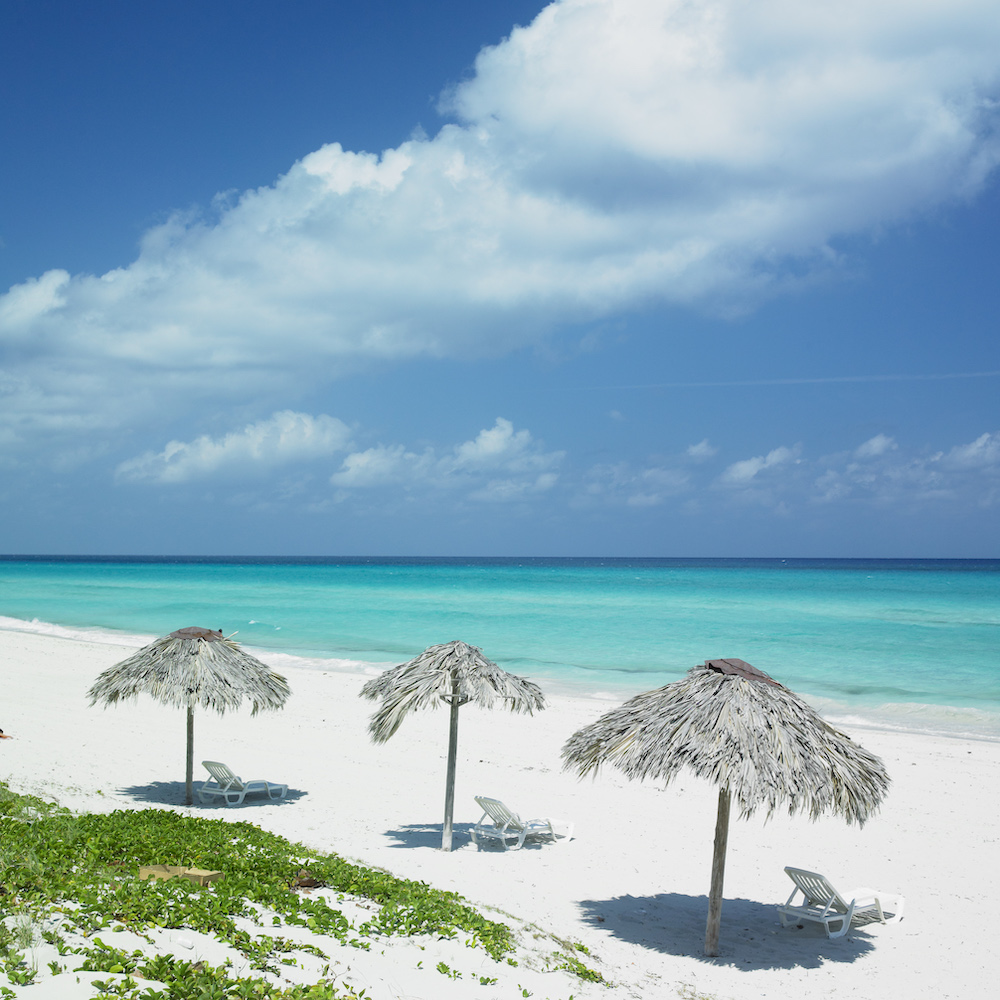
89. Cool off at Cueva de Saturno, Saturn Cave – this 70 ft deep cenote or sinkhole was the perfect respite on our way to Varadero. We stopped here for a quick swim, and while I was skeptical at first, having never swum in a cenote, it turned out to be a real treat! For more adventurous folks, you can rent snorkeling and scuba gear, a popular activity at the cenote.
Tip: To beat the crowds, I recommend arriving first thing in the morning as the cenote attracts many visitors and can get very busy.
90. Go Dancing at Palacio de la Rumba de la Habana – this nightclub attracts locals and tourists alike who are looking for a night filled with dancing and fun. No one arrives at the club before 11:00 p.m., so make sure to take a nap before your nocturnal adventure begins!
Tip: Be sure to bring toilet paper with you as the bathrooms tend to run out or pay a small fee for literally a sheet of tp.
Viñales
Located in the Pinar del Río province, about 2.5 hours outside Havana, it is known for its striking karst lush green landscape surrounded by mountains. Viñales offers spectacular views lots of great activities such as horseback riding, ziplining, and, my favorite, lessons on rolling a Cuban cigar.
Fun Fact: Vinales is said to be Fidel Castro’s favorite place in Cuba.
91. Rent a Bike – riding around Viñales by bike is an excellent way to sightsee and explore the area. Expect to see cow-pulled carts along the streets and lush green tobacco fields! Bicycles are available to rent from the local tout at the main square. Price: $6 for 5 hours
92. Go zip-lining with Canopy Tour El Fortin – if you’re feeling adventurous and want to experience zip-lining through the picturesque lush landscape for just $8, then the Canopy Tour is for you! If you’ve never been zip-lining, then do not worry; the instructors are accommodating, friendly, and speak English. I loved zipping through the trees and screaming at the top of my lungs. Talk about enjoyment!
93. Visit the Mural de la Prehistoria – make sure to head over to the Mural de la Prehistoria for, at the very least, a quick photo. After taking a few pictures, check out the gift shop and the bar, and then move on to your next adventure!
94. Take a boat right through the Cueva del Indio, India Cave – just a few miles outside Viñales; this fascinating subterranean underground cave has impressive rock formations that appear along the cave walls. The boat ride is short and an excellent way to escape the heat.
Tip: Ask the cave attendant how many people are already in the cave before heading down. If the wait is longer than 30 minutes to board the boat, I recommend coming back later.
95. Visit a Tobacco Farm – was one of the highlights of our day. Our driver took us to Ruta del Tabaco, where we learned about the history of tobacco on the island and what makes Cuban cigars so unique. Additionally, we had the opportunity to see the production of coffee and honey.
Tip: If you’re looking to purchase cigars, wait until you get to Viñales. You’re guaranteed to get the freshest and most authentic cigars directly from the source! Alternatively, if you don’t have time to visit a tobacco farm, you can purchase cigars in the tobacco shops on the main street.
96. Learn How To Roll a Cigar – rolling your own cigar is a uniquely Cuban experience. It’s a form of art, and I can’t think of a better place to learn from the best! At the tobacco farm, you will have the opportunity to learn how to roll your very own cigar.
97. Smoke a Cigar – after you’ve rolled your cigar, it’s time to light it! If you are on a Cuban Finca, then you can follow the instructor’s lead. I’m not a cigar smoker, but I couldn’t pass up the chance to at least try my first hand-rolled cigar. That wouldn’t be right!
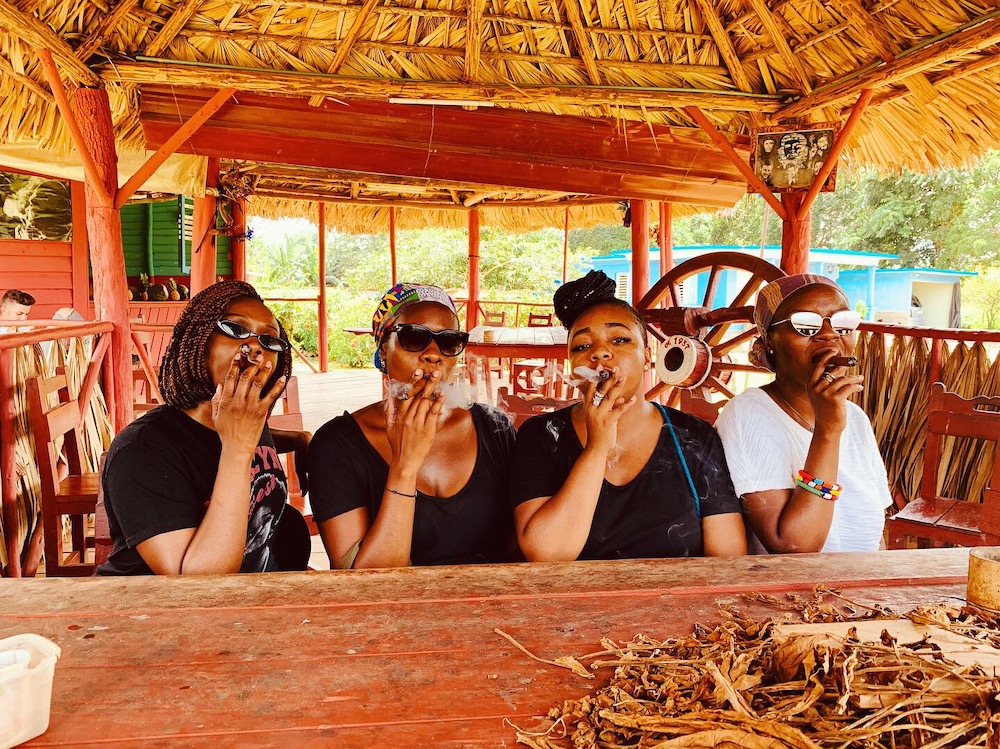
98. Go Horseback Riding – through the lush tobacco fields while admiring the spectacular scenery. This adventure is a fun and unique way to see and learn about the rural Cuban lifestyle.
Tip: If you’re not a fan of horse-like myself, ask about a horse cart ride. It’s a good option for families with small children.
99. Take a Hike Through Santo Tomas Cave – If you have time to spare, hire a guide for $15 and check out Cuevas de Santo Tomas, Cuba’s largest cave. The 2-hour tour is trekked using head torches to light the way and is suitable for hikers of all levels. The cave is 30 minutes outside of Viñales, so plan accordingly.
Tip: Be sure to wear comfortable shoes.
100. Admire the views at the Overlook of Viñales National Park – before leaving Viñales, make sure to stop at the overlook for a breathtaking view of the Valle de Viñales, Viñales Valley, which is a short taxi ride away from the city center. You’ll know you’re in the right place by not only the views of the stunning valley the incredible pool at the Hotel Los Jazmine.
101. Have Fun!
I’ve said it once and I’ll say it again: Cuba is a place to experience and not necessarily be seen. Take advantage of going off the grid for a few days. Get lost in the culture. Cuba, like every country, has its own set of unique issues, but I highly recommend staying present, open-minded, and flexible. Your trip will be much more enjoyable!
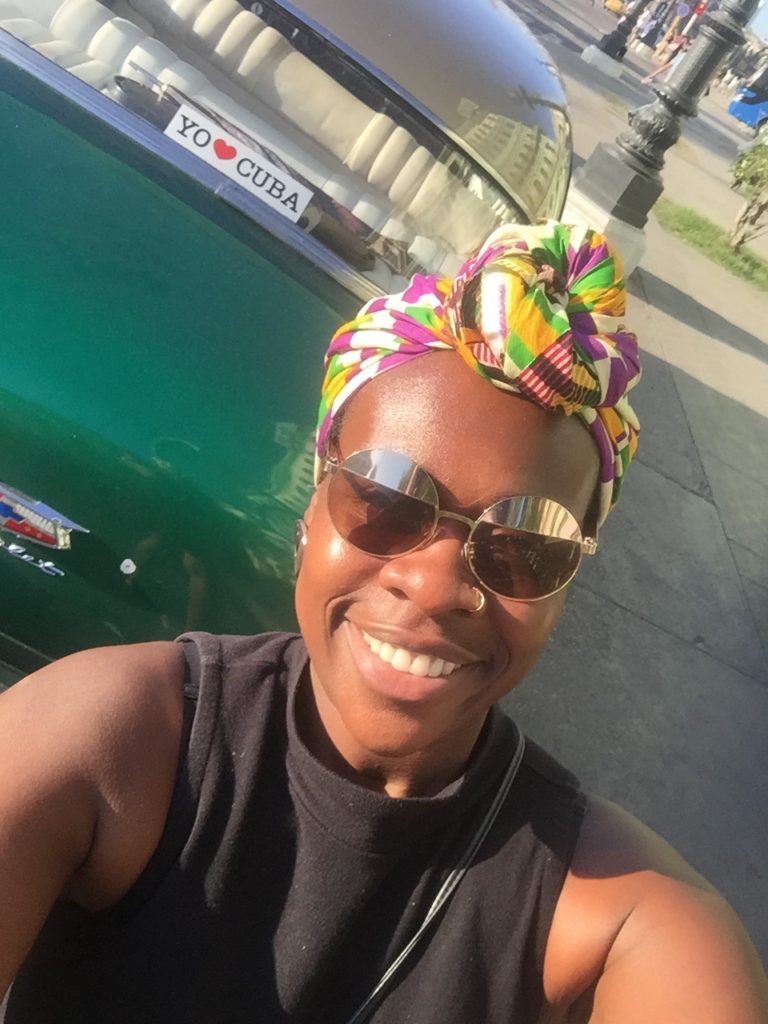
Conclusion – Lady Chin’s Two Cents
While this is a pretty extensive list, it’s not an exhaustive list of things to do while in Cuba. If you’re limited on time, pick a few activities and be realistic with your time. Don’t be like me and overextend yourself to the point where you’re wiped out and have a little downtime to rest. That defeats the whole point of vacation!
What did I miss? Comment and share below! What are some of your must-do things to do in Cuba?
If you liked this post, please don’t forget to share!
